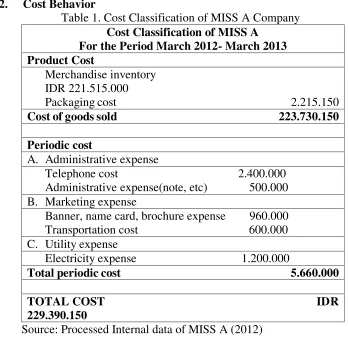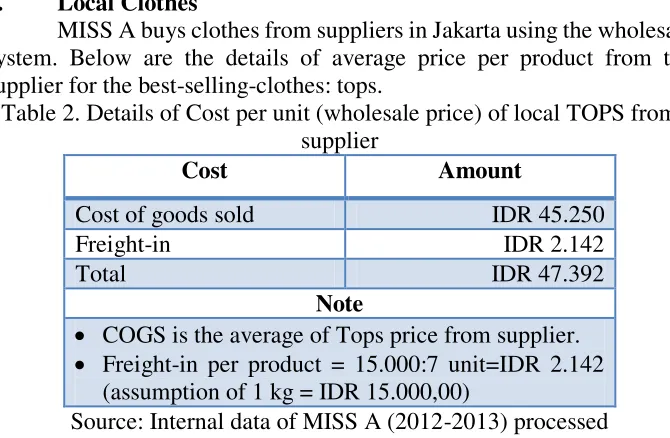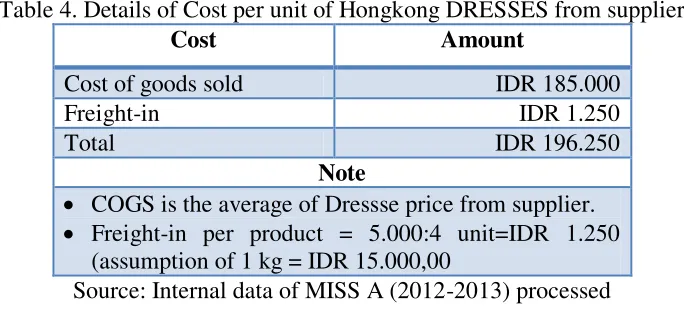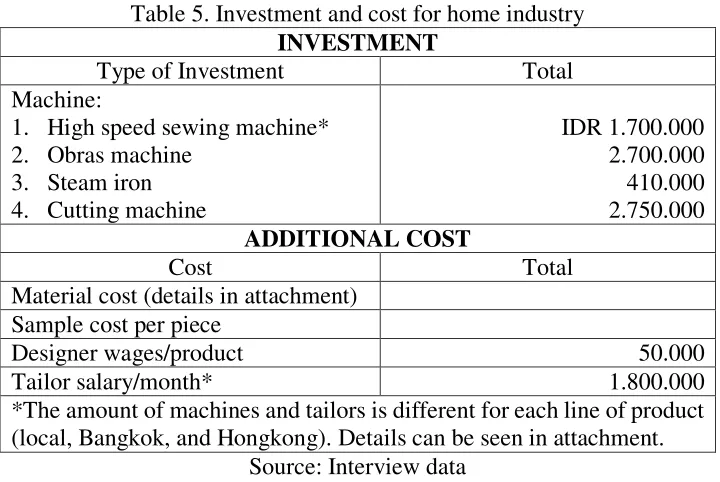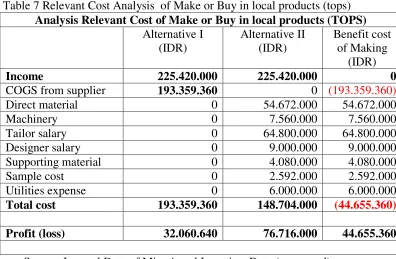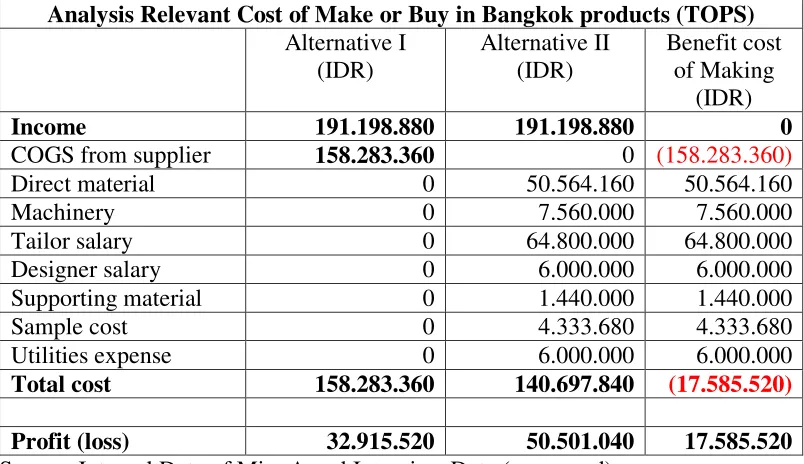TACTICAL DECISION MAKING IN TERMS OF BUYING FROM SUPPLIER OR SELF-PRODUCING USING RELEVANT COST IN
“MISS A” FASHION BUSINESS
Meliyana Prasetyo Tejo
Universitas Ciputra Surabaya, Indonesia
Abstract:
This research discusses about tactical decision making using relevant cost analysis as a basis for make-or-buy decision making in MISS A Company. This study aims to determine the decision that should be made by MISS A in order to grow and face the fierce rivalry in the fashion industry. MISS A company faces options to keep buying from supplier or start building home industry and self-producing. This study uses documentation, interview, and observation to collect the data. The method used in this study is relevant cost analysis which compares relevant costs and benefits in the decision making process. The findings of this study indicate that relevant cost analysis can be used in short-term decision making. The company should also consider the long-term impacts of the decisions made. The best decision for the company to make is to keep buying from supplier for Bangkok dresses line and to self-produce for local tops, Bangkok tops, and Hongkong dresses lines. This study is limited and conducted as short-term decision
making based on the company’s internal data between 2012 and
2013.
CHAPTER 1. INTRODUCTION
In the current modern era, business grows and innovates in fast pace to fulfil people’s need. Since a long time ago, business has taken a crucial part in our society and simply cannot be separated from our economy. In order to grow bigger and survive, decision making holds the
biggest part in a business’ sustainability. No matter how small or big the
businesses are, they should make the best decisions in order to keep
running the business, compete with the competitors, and serve customers’
needs. Above all, every business needs to think and take decisions wisely
in order to reach the company’s goal. To keep up with the reasons, a
business should consider its decisions carefully, because every decision affects the company.
According to Harvard Center for Textile and Apparel Research, fashion industry is one of the timeless business types besides food and beverage, technology, entertainment, and property. These business types will remain because people always need them.
According to Mari Pangestu (2009), fashion industry is one of the industries that belongs to creative industry. In 2011, creative industry
contributed 7,2% to Indonesia’s GDP. It also absorbed around 2,6 million
workers. There are huge opportunities in fashion industry, both domestic and international. In general, fashion industry gives significant
contribution towards Indonesia’s economy. It creates positive climate for business, strengthens Indonesia’s image and identity, and acts as the center
of innovation and creativity. With those reasons, there is an urgency to develop fashion industry (Pangestu, 2009:20).
The rise of modern technology also brings opportunity for fashion
industry. Currently, Indonesia’s fashion industry revolves in online media, such as the use of ‘Blackberry Messenger’, Facebook, and Instagram to sell products. Based on Kominfo data on April 2012, Indonesian users in social media are significant, reaching 65,1 million in total. Consequently, online business becomes a new way to reach this limitless market size.
“Miss A”, a fashion business which was established to fulfil the Entrepreneurial Project course in Universitas Ciputra on December 2011,
is currently an online business that sells women’s clothing. Miss A
Picture. 1 Graphic of Miss A’s Sales and Profit
Source: Internal data of Miss A
From the graphic, it can be seen that Miss A’s sales is fluctuating.
There were huge sales in certain months such as July 2012, because people began to prepare for Eid Mubarak, and also in February 2013, when people welcomed the Chinese New Year. Meanwhile, there were no sales in June 2012 and November 2012. In these months, Miss A restocked, managed the remaining stock, and took care of pre-order problems.
Local clothes which have the lowest price contribute huge sales, but they give the lowest profit. Imported clothes (from Bangkok and Hongkong) which are currently new, contribute less sales but with higher profit margin. During the time, local clothes contribute the most for Miss
A’s growth. Local clothes have cheaper price and are fast-moving products. Miss A also started by selling local ones, then expanded to imported clothes. From the graph, we can see that after Miss A began to sell imported clothes, the profit was rising up (since September 2012).
Local and imported clothes have their own advantages. Because
Miss A’s strength is in local clothes, there are several problems that should be overcome. Basically, Miss A’s local clothes’ model and quality are
almost the same with its competitors. This condition makes the rivalry in local clothes fierce. Customer loyalty is so low. They can easily move to other sellers which offer cheaper price.
0 10,000 20,000 30,000 40,000 50,000 60,000 70,000
Sales (in thousand)
During the time, Miss A gives good service to maintain buyers.
That’s why Miss A can still compete in local clothes market. However,
local clothes’ quality isn’t always good. Sometimes, there are defect cloths that bring financial loss to the company. The profit for local clothes is also too low. This means if there are many defect products, the loss will be big.
Brand awareness isn’t of help either in local clothes rivalry. There are always some online businesses that go below the market price and cause loss to others. However, since the sales of local clothes are high, Miss A simply cannot abandon the local product.
Meanwhile, in imported clothes competition, especially
Bangkok’s, the price range is almost the same, but not as strict as local
clothes. Imported clothes give more profit margins to Miss A. Although there are a few buyers and resellers for these lines, the two lines have a good prospect in the future. In fairness, the qualities of imported items are very good. With these products, Miss A does not need to worry about product defect. However, there will be a lot of competitors for imported clothes with the same product, even price, in the near future.
Considering the situation and the problems that appear, the management should devise a strategy that will help the company. Under the situation of having too many competitors with the same price, model, defect product, low loyalty, and also the desire to build brand awareness,
Miss A is faced with several alternatives. It is Miss A’s vision to be a world
class apparel business, so in the end, it will be better if Miss A starts making its own clothing line. This is the first alternative. However, there is a question whether it is more profitable to self-produce or not. Can Miss A get more profit from producing than just rebranding and being a distributor? How much will it cost to establish a home industry, hire tailors and sewing machines? Wouldn’t it be complicated to produce, market, and supervise workers?
Miss A faces an urgency to choose the best decision for the company, both for short-term and long-term purposes. A good decision can be made by considering future possibilities and other factors through analysis and calculation. In the end, the company can determine the best decision to keep buying from supplier or to produce clothes by itself.
Therefore, this paper will observe about “Tactical Decision Making in Terms of Buying from Supplier or Self-Producing Using
Relevant Cost in “Miss A” Fashion Business.” Moreover, this paper aims to:
2. Give consideration for company management about relevant cost as an alternative of decision making
1.1.Previous Research
There are three researchs used as sources in this paper. The first research created by Ishmael and Osamor I.P. (2012). This research is sourced from Australian Journal of Business and Management Research Vol.2, No.03, 2012. The journal aims to examine the concept of relevant cost, its relevance in decision making analysis, its advantage in both short and long-term planning, and its influence in the decision maker’s preference. Based on related literature, it is revealed that relevant costs are costs that are appropriate for a specific management decision. They are estimated future costs that are different under alternative courses of action for a specific problem. Relevant cost should consist of both fixed and variable costs.
The analysis technique in the journal compares two decisions that can be chosen by noticing the variable and calculating the opportunity and profit. The result of the tactical decision making using relevant cost theory says that Decision 1 (X1) should be compared with Decision 2 (X2). The one that has more value (profit) and opportunity cost is the better decision to make.
Another resource comes from a research by Pachori and Karunesh
Saxena (2012). The journal aims to help India’s automotive industry keep
up with the fierce competition in automotive industry with the help of relevant cost in the decision making process. Relevant cost is the solution in determining the area of material requirement, making or buying decision, accepting or rejecting special order, creating equipment replacement decision, making the best use of scarce resources, and adding or dropping a product line. The analysis technique compares the choices in cost, opportunity, and profit. The one that brings more advantages is the one that the decision maker must follow.
1.2.Cost
1.2.1. Definition of Cost
Cost is a sacrifice in economic resources measured in money unit that has happened or will happen for certain purpose. (Mulyadi, 2011:8). The term cost is very elusive. It has different meanings in different situations. A cost accountant examines each situation in depth to decide the type of cost concept that he will use and it is an important thing in a decision making to make precise and relevant data available to management. In cost studies, a cost accountant should always consider four points in the decision-making process, which are to:
1. Establish why a choice is necessary.
2. Analyze each available alternative separately.
3. Determine how every alternative alters or influences the decision
maker’s preference.
4. Choose a course of action from the alternatives.
1.2.2. Cost Behavior
Cost behavior refers to how cost will react to business activity (Garrison et al., 2010:189). Understanding cost behavior is the key to a decision making within a company. Managers who understand how cost behaves will be able to predict better regarding how much cost is involved in the business operation.
In general, there are 3 types of cost behaviors; which are fixed cost, variable cost, and semi-variable cost.
1. Fixed Cost
A cost that does not change with an increase or decrease in the amount of goods or services produced. The amount of fixed cost in a period remains fixed. (Rich et al,. 1010:757). Example: salary
2. Variable Cost
Variable cost is a cost that varies depending on a company's production volume. It rises as production increases and falls as production decreases (Rich et al,. 1010:760). Example: material cost
3. Semi-Variable Cost
levels of production increase total cost. If no production occurs, then a fixed cost is still incurred. Example: water and electricity
1.2.3. Relevant Cost
Relevant cost is the key in tactical decision making. These costs are appropriate for a specific management decision. Relevant costs are future costs that are different under alternative courses of action for a specific problem. A cost item is relevant to the decision if it influences the
decision maker’s choice (Ishmael, 2012).
Relevant cost, which is also named differential cost, is a cost that differs between the alternatives being considered (Hilton et al., 2008:520). It is often important for businesses to distinguish between relevant and irrelevant costs when analyzing alternatives, because considering irrelevant costs erroneously can lead to unsound business decisions. Also, ignoring irrelevant data in analysis can save time and effort. Non-cash items, such as depreciation and amortization, are frequently categorized as irrelevant costs, since they do not impact cash flows (Saxena,2012:220).
Two common types of irrelevant costs are sunk costs and future costs that do not differ between alternatives. Sunk costs are unavoidable because they have already been incurred. Future costs that do not change between alternatives are also essentially unavoidable with respect to the alternatives being considered.
1.3. Decision Making
Decision making is one of the major functions of a management. It is a very important and difficult task of management. Decision making can be defined as making a choice between uncertain future alternatives. A short-term practical decision making consists of choosing among alternatives with an immediate or limited end in view. It must be emphasized that all decision makings relate to the future and that a decision is a choice between alternatives in the pursuit of objectives.
1.3.1. Tactical Decision Making
Tactical Decision Making means of choosing among alternatives with an immediate or limited end in view (Hansen and Mowen, 2011:820). Tactical decisions are short term in nature. They are short-term actions which serve a larger purpose in the long run.
alternative, comparing relevant costs and benefits for each alternative, relating each alternative to the overall strategic goals of the firm and other important qualitative factors and selecting the alternative with the greatest
benefit which also supports the organization’s strategic decisions.
1.4. Tactical Decision Making Application with Relevant Cost Relevant cost is very useful in determining decisions for some cases, such as the decisions to accept or reject order, make or purchase, increase, decrease, or stop production, calculate opportunity cost, determine the price, sell or further production, and outsource decision (Oliver and Horngren, 2010:461).
Generally, decisions to manufacture or purchase are faced by companies that have many kinds of products. A company does not always have to produce the products by themselves. They can purchase it from other people if the cost is lower than producing it. Therefore, when other parties offer cheaper price, the company needs to reconsider their options. In conclusion, relevant cost concept can answer the main problem in Miss A, that lies between self-producing or buying from supplier.
1.5. Analysis Model
Picture 2. Analysis Model Source: Research result
Data Collection (cost, material price, etc)
Analysis of Relevant Cost
Self-producing Buying from
Final decision to self-producing or keep buying
CHAPTER 2. RESEARCH METHOD
2.1. Research Approach
The research approach used in this research is qualitative action research. Qualitative research refers to a research procedure that aims to understand the phenomenon of the subject that will result in descriptive data (Moleong, 2010:4). In this research, qualitative analysis is conducted
by examining the company’s alternatives using relevant cost concept to
decide the best way that influence managerial decision.
The research type used in this research is descriptive method. Descriptive method aims to collect actual information in details that can
bring better understanding on the research’s object (Sanusi, 2011:15).
2.2. Research Object
This research used both qualitative and quantitative data. Quantitative data is related to the application of relevant cost, such as cost of goods sold of the clothes from various suppliers during March 2012-March 2013 and production cost in self-production. Quantitative data also
emphasized on MISS A’s financial report to measure the sales forecast in
relevant cost analysis. Meanwhile, qualitative data is related to company history and structure, and production process.
2.3. Data Collection Procedure
The data sources for this proposal belong to primary data which come directly under original source and direct observation. The primary
data come from Miss A’s data of supplier’s price and observation of
production cost if Miss A self-produces. The research object used in this research is selected using non-probability sampling method with purposive sampling. The methods of data collection used are:
1. Documentation; refers to a way of collecting data using documents that are related to the problems, or finding data on variables such as transcript, note, book, etc (Arikunto, 2009:206)
2. Observation; a way to collect data with direct monitoring of the observation object, which is the company.
After the data collected, triangulation method is used to validate the data between the writer as business owner and the source (from documentation and interview).
2.4. Scope of the Research
The scope of this research is divided into two limitations that consist of time and place (scope). The limitation of place is the online store (supplier) in Java, Surabaya. Meanwhile, the time limitation is between March 2012 and May 2013.
2.5. Data Analysis Technique
Tactical decision making is about choosing the best choice among others. In order to fulfill the purpose of the research, the analysis techniques involve:
1. Identifying the problem. 2. Determining the alternatives.
3. Collecting qualitative and quantitative information. The information sources are taken from Miss A’s price data between 2012 and 2013, cost and price from convection, production cost, and production capacity.
4. Recording, summarizing, and making a brief description. 5. Classifying data into related alternatives and presenting them.
6. Processing data by conducting an analysis of relevant cost to find a pattern and category and presenting the finding. When the choice is between two alternatives, an emphasis should made to find out the advantages of taking a particular decision. The steps taken are:
1. Identifying revenue for each alternative.
2. Identifying cost for each alternative and taking in a particular care to include opportunity cost.
3. Identifying profit for each alternative and profit (loss) of choosing one alternative over another.
7. Analyzing the financial aspects from the alternatives to know how the
alternatives affect the company’s activity, resources, and profit based
on these indicators:
1. Making or buying decision is made if differential cost of the decision alternative of buying is less, whereas if the differential
cost in buying is higher, the company shouldn’t make the product
(Oliver and Horngren, 2010:480).
3. Tactical decision making is a small part in a company’s strategy to reach higher profit in the future (Hansen and Mowen, 2011:820). Relevant cost concept is usually followed by forecasting method of 2 to 5 years to see the long-term effect.
Financial analysis gives a picture of the company’s financial
condition that becomes a principle in decision making and projecting future prospect. (Crosson et al., 2010:2013).
8. Deciding on the most profitable decision based on relevant cost calculation and considering financial indicators.
CHAPTER 3. DATA ANALYSIS AND DISCUSSION
3.1. Company Overview
MISS A is a small-medium enterprise that engages in fashion
industry and focuses on women’s clothing. This company was established
as a part of a school project at Universitas Ciputra on December 2011.
MISS A’s main activities involve running an online media and using
Blackberry Messenger. The business concept is basically about an online business that wants to capture the unlimited market size in the field, in both domestic and international markets. Furthermore, as a distributor and reseller of fashion product, MISS A also supplies several boutiques in Surabaya.
3.1.1. Product
MISS A provides the market with two lines of product; local and imported ones (Bangkok and Hongkong). The most favorite local products are tops. These products are priced between IDR 40.000 to IDR 90.000. Bangkok products are priced between IDR 90.000 to IDR 300.000. The most favorite Bangkok product are tops and dresses. Meanwhile, the price range for Hongkong clothes are between IDR 170.000 to IDR 1.000.000. The most favorite Hongkong product are dresses.
3.1.2. Segment and Target Market
MISS A is segmenting the market based on demography and
psychograph. From the segmentation, MISS A’s target market are: 1. Local clothes
The target markets are resellers, housewives, employees, and students from middle to low class because the price is cheap. The targeted age is around 15-40 years old for local clothes model.
The target markets are resellers, housewives, businesswomen (employees or entrepreneurs), and students in middle high class who care about quality. The targeted age is around 15-55 years old for imported clothes model.
3.2. Cost Behavior
Table 1. Cost Classification of MISS A Company Cost Classification of MISS A
For the Period March 2012- March 2013 Product Cost
Merchandise inventory IDR 221.515.000
Packaging cost 2.215.150 Cost of goods sold 223.730.150
Periodic cost
A. Administrative expense
Telephone cost 2.400.000 Administrative expense(note, etc) 500.000 B. Marketing expense
Banner, name card, brochure expense 960.000 Transportation cost 600.000 C. Utility expense
Electricity expense 1.200.000
Total periodic cost 5.660.000
TOTAL COST IDR 229.390.150
Source: Processed Internal data of MISS A (2012)
3.3. Relevant Cost
3.3.1. Identification and Problem Description
MISS A started with local clothes, and on September 2012 began to sell imported (Bangkok and Hongkong) clothes. The company took the products from Surabaya and Jakarta. Local and imported clothes have their own strengths and weaknesses. Local clothes have low quality; product defects, low profit margin, and tough competition. Meanwhile, imported clothes have very good quality with higher price. In the near future, the rivalry in the imported clothes business will be as fierce as the local one.
3.3.2. Analysis of Alternatives
3.3.2.1. Alternative I: Buying from Supplier
1. Local Clothes
MISS A buys clothes from suppliers in Jakarta using the wholesale system. Below are the details of average price per product from the supplier for the best-selling-clothes: tops.
Table 2. Details of Cost per unit (wholesale price) of local TOPS from supplier
Cost Amount
Cost of goods sold IDR 45.250
Freight-in IDR 2.142
Total IDR 47.392
Note
COGS is the average of Tops price from supplier. Freight-in per product = 15.000:7 unit=IDR 2.142
(assumption of 1 kg = IDR 15.000,00)
Source: Internal data of MISS A (2012-2013) processed
2. Imported Clothes
MISS A buys clothes from suppliers in Jakarta and Surabaya for Hongkong and Bangkok. Below are the details of average price per product from supplier for the best selling Bangkok clothes (tops) and Hongkong clothes (dresses).
Table 3. Details of Cost per unit of Bangkok TOPS from supplier
Cost Amount
Cost of goods sold IDR 107.777
Freight-in IDR 2.142
Total IDR 109.919
Note
COGS is the average of Tops price from supplier. Freight-in per product = 15.000:7 unit=IDR 2.142
(assumption of 1 kg = IDR 15.000,00)
Table 4. Details of Cost per unit of Hongkong DRESSES from supplier
Cost Amount
Cost of goods sold IDR 185.000
Freight-in IDR 1.250
Total IDR 196.250
Note
COGS is the average of Dressse price from supplier. Freight-in per product = 5.000:4 unit=IDR 1.250
(assumption of 1 kg = IDR 15.000,00
Source: Internal data of MISS A (2012-2013) processed
3.3.2.2.Alternative II: Self-Producing (Setting up Home Industry) with Pre-order System
To build a home industry for clothing, we must consider place, resources, fund, and cloth-making skills. The next step is resources. There are several resources needed, such as high speed sewing machine, obras machine, steam iron, designer, model, and tailors.
The process of producing clothes begins with designing or sketching. The owner and designer need to find ideas for clothes. The next step is sampling. The idea is made into clothes by the tailor. Then, the sample will be worn by a model in a photo session. After the photo shoot, MISS A will open a pre-order (PO) for the clothes. The pre-order system
will minimize materials that MISS A doesn’t require. After the orders
fulfill the quota, the production process is started. The process includes making pattern, cutting fabric, sewing/assembling, inspecting (quality control), finishing (ironing the clothes), and packing. Each tailor will manage each step of the production. One is assigned to make pattern, another to sew, and the last one is in charge of ‘obras’. The job desk is clear and efficient. At the end of the day, the finished goods will be packed and delivered to the customers and resellers.
Table 5. Investment and cost for home industry
*The amount of machines and tailors is different for each line of product (local, Bangkok, and Hongkong). Details can be seen in attachment.
Source: Interview data
In order to know how many clothes MISS A should produce in self-production (alternative II), the researcher will make a financial projection to determine the amount of production based on sales volume historical data of MISS A in 2012-2013.
Table 6. Sales Volume and Projection of MISS A between March 2012 and March 2013
Self-*Assumption of increase in sales volume is 15% (ceteris paribus) *Bangkok and Hongkong product were sold since September. Average per month=total volume:7 months. Projection in 2014 for Bangkok and Hongkok products use total volume in a year (average volume x 12 x 115%)
Source: Internal Data of MISS A (processed)
3.4. Relevant Cost Analysis
Based on quantitative relevant cost information, below is the analysis of relevant cost that helps MISS A to decide on the most profitable result between alternative I (buy) and alternative II (make).
Table 7 Relevant Cost Analysis of Make or Buy in local products (tops) Analysis Relevant Cost of Make or Buy in local products (TOPS)
Alternative I (IDR)
Alternative II (IDR)
Benefit cost of Making
(IDR)
Income 225.420.000 225.420.000 0
COGS from supplier 193.359.360 0 (193.359.360)
Direct material 0 54.672.000 54.672.000
Machinery 0 7.560.000 7.560.000
Tailor salary 0 64.800.000 64.800.000
Designer salary 0 9.000.000 9.000.000
Supporting material 0 4.080.000 4.080.000
Sample cost 0 2.592.000 2.592.000
Utilities expense 0 6.000.000 6.000.000
Total cost 193.359.360 148.704.000 (44.655.360)
Profit (loss) 32.060.640 76.716.000 44.655.360
Source: Internal Data of Miss A and Interview Data (processed)
2.671.720/month), which cannot support the life of the company. In conclusion, from the quantitative data obtained, alternative II (self-producing) is more beneficial.
Table 8 shows relevant cost analysis in Bangkok tops. From the comparison between buying and making, alternative II shows greater profit which is IDR 50.501.040 ,00per year or IDR 4.208.420,00 per month. The difference between buying and self-producing is IDR 17.585.520. At the end of the day, self-producing is worth trying based on the quantitative information.
Table 8 Relevant Cost Analysis of Make or Buy in Bangkok products (tops)
Analysis Relevant Cost of Make or Buy in Bangkok products (TOPS) Alternative I
Income 191.198.880 191.198.880 0
COGS from supplier 158.283.360 0 (158.283.360)
Direct material 0 50.564.160 50.564.160
Machinery 0 7.560.000 7.560.000
Tailor salary 0 64.800.000 64.800.000
Designer salary 0 6.000.000 6.000.000
Supporting material 0 1.440.000 1.440.000
Sample cost 0 4.333.680 4.333.680
Utilities expense 0 6.000.000 6.000.000
Total cost 158.283.360 140.697.840 (17.585.520)
Profit (loss) 32.915.520 50.501.040 17.585.520 Source: Internal Data of Miss A and Interview Data (processed)
Table 9 Relevant Cost Analysis of Make or Buy in Bangkok Products (dresses)
Analysis Relevant Cost of Make or Buy in Bangkok products (TOPS) Alternative I
Income 117.720.000 117.720.000 0
COGS from supplier 97.662.240 0 (97.662.240)
Direct material 0 45.133.200 50.564.160
Tailor salary 0 43.200.000 64.800.000
Designer salary 0 2.400.000 6.000.000
Supporting material 0 1.440.000 1.440.000
Sample cost 0 3.104.880 4.333.680
Utilities expense 0 6.000.000 6.000.000
Total cost 97.662.240 108.838.080 11.175.840
Profit (loss) 20.057.760 8.881.920 (11.175.840) Source: Internal Data of Miss A and Interview Data (processed)
Table.9 shows that buying from supplier is better than self-producing for Bangkok dresses. Although alternative II still gives profit, the profit is greater if MISS A keeps buying from the supplier (IDR 20.057.760 per year). However, with the amount of profit, the company will not grow if it only sells Bangkok dresses, because the income per month is so low (IDR 1.671.480,00).
Table 10 Relevant Cost Analysis of Make or Buy in Hongkong Products (dresses)
Analysis Relevant Cost of Make or Buy in Bangkok products (TOPS) Alternative I
COGS from supplier 51.405.000 0 (51.405.000)
Direct material 0 24.840.000 24.840.000
Machinery 0 7.560.000 7.560.000
Tailor salary 0 21.600.000 21.600.000
Designer salary 0 1.200.000 1.200.000
Supporting material 0 552.000 552.000
Sample cost 0 2.208.000 2.208.000
Utilities expense 0 6.000.000 6.000.000
Total cost 51.405.000 63.960.000 12.555.000
Profit (loss) 24.495.000 11.940.000 (12.555.000) Source: Internal Data of Miss A and Interview Data (processed)
Nevertheless, as the time goes by, if MISS A’s capability to sell Hongkong
product is increased, reaching more than 6 units per day, MISS A could try to self-production.
3.5. Tactical Decision Making (Make or Buy in MISS A)
Relevant cost analysis shows that alternative II (self-producing) is a better option for local tops and Bangkok tops. From the cost point of view, self-producing is proven to be more efficient than buying from supplier. Self-producing also contributes more profit to the company than buying. Meanwhile, the profit of self-producing for Bangkok and Hongkong dresses is smaller than buying from supplier, because MISS A only capable to sell small amount of the clothes now. Although self-producing still gives profit, it will be better if MISS A keeps buying from
suppliers for Bangkok and Hongkong dresses. Furthermore, MISS A can’t
survive only by selling Bangkok and Hongkong dresses, considering the low profit per month.
In addition to the quantitative information, the company must pay attention to qualitative information. Buying from suppliers gives advantages of having more models and using less time, because the
company doesn’t need to allocate time to create and produce. On other
hand, buying from supplier means that MISS A will have almost the same products, or even the same products, with the competitors and it may lead to a price war. Furthermore, there is a possibility that the supplier suddenly breaks the cooperation contract. This will affect the company stock greatly. For imported clothes, the price is affected by the exchange rate. If the exchange rate is higher, the product will be more expensive.
3.6. Discussion: Tactical Decision Making Application with Relevant Cost in MISS A Fashion
Tactical decision makings are short-term actions which serve a larger purpose in the long run. From the quantitative and qualitative aspects, the best decision is self producing for local clothes and Bangkok tops. According to the analysis, machinery investment can reach a breaking point before a year and the company can get profit. In the next year, if the company decides not to add the machinery, the profit will be
higher because they don’t spend additional cost.
According to the decision made based on tactical decision making, there are some managerial implications that should be done by MISS A. MISS A will begin to self-produce and sell the product under MISS A’s
brand as one of company’s competitive advantages. The company should
order to be able to create what customers want. MISS A should also make innovations that set their product apart from the market products. In the future, MISS A can expand other product lines through market survey. From the marketing side, in addition to selling through online media, MISS A can start to be more involved in B2B. As a home industry that produces its own clothing line, MISS A can do consignation and sell the clothes through distributors, resellers, and boutiques (online and offline). Finally, to boost brand awareness, MISS A should join some public events.
CHAPTER 4. CONCLUSION
Based on the data analysis, the researcher can make a decision by implementing relevant cost analysis in the make-or-buy decision in MISS A FASHION. Relevant cost analysis helps in short-term decision making by considering both quantitative and qualitative factors. Even though relevant cost is useful in short-term decision making, the decision gives impact in the long run.
Based on the research, MISS A should choose alternative I (buying from supplier) for Bangkok and Hongkong dresses. Relevant cost analysis shows that the company will get higher profit if it keeps buying from supplier. As seen from the qualitative factor, buying from supplier has its advantage in having more models and using less time, because the
company doesn’t need to allocate time to create and produce.
Meanwhile, MISS A should choose alternative II which is self-producing for local tops and Bangkok tops. Relevant cost analysis shows that self-producing contributes higher profit for those lines. Furthermore, self-producing of local tops and Bangkok tops contributes more than 50 million profit for MISS A. Considering the qualitative information, self-producing has advantages in increasing brand awareness, being different
from the competitor, and reaching MISS A’s vision to be world class
apparel. Although establishing and managing home industry is not easy, at the end of the day, it is worth considering what the company will get in return.
The limitation of this research is time that lies between March 2012 and May 2013. Meanwhile, the modern era revolves in fast way. Therefore, there is opportunity for the next research to review whether the decision now is still able to execute in the next few years or not. Furthermore, the next research could observe about company and industry performance to notice if there are problems occurred along with the advanced of time. Competition will be fiercer in the years ahead especially
opportunity to create research about innovation and brand awareness that could help MISS A standing in the competition.
REFERENCES
Hansen, Don R., Dan L. Heitger, Jefferson P. Jones, Mowen. 2010. Cornerstones of Financial & Managerial Accounting. USA: South-Western Cengage Learning.
Hansen, D. R. and M. M. Mowen. 2011. Cornerstones of Cost Accounting. United States of America: South-Western Cengage Learning.
Hilton, R. W. 2008. Cost Management Strategies of Business Decision. New York: McGraw-Hill.
Hilton, R. W. 2008. Managerial Accounting: Creating Value in a Dynamic Business Environment Sacarath Edition. New York: McGraw-Hill.
Ishmael, Osman. 2012. Relevant Cost Concept: A Glaring
Dichotomy-Accountant’s Perspective. Australian Journal of Business and Management Researc., 2(3):25-32.
Kuncoro, M. 2009. Metode Riet untuk Bisnis dan Ekonomi Edisi 3. Jakarta: Penerbit Airlangga.
Mowen, M. M., et al. 2009. Cornerstones of Managerial Accounting Third Edition. United States: South-Western Cengage Learning.
Oliver, M. S. and C. T. Horngren. 2010. Managerial Accounting. New Jersey: Pearson.
Pangestu, Mari. 2009. Pengembangan Ekonomi Kreatif Indonesia 2025. Departemen Pedagangan Republik Indonesia.
Patarianto. 2012. Penggunaan Analisis Biaya Variabel dalam Pengambilan Keputusan Produksi pada PT. PTJ Kantor Wilayah Sidoarjo. Journal Media Mahardika Vol. 10, No. 3.
Rich, J. S. et al. 2010. Cornerstones of Financial and Managerial Accounting. Canada: South-Western
http://indonesiakreatif.net/creative-economy/research/
http://smgapps.bu.edu/smgnet/Personal/Faculty/Publication/pubUploads New/WP2005-23.pdf?did=541&Filename=WP2005-23.pdf
http://www.kompas.com, accessed at 19 August 2013
